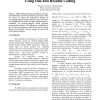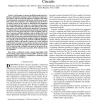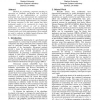16 search results - page 2 / 4 » Arithmetic Circuits Combining Residue and Signed-Digit Repre... |
ARITH
2009
IEEE
14 years 2 months ago
2009
IEEE
Moduli of the form 2n ± 1, which greatly simplify certain arithmetic operations in residue number systems (RNS), have been of longstanding interest. A steady stream of designs fo...
ISLPED
1995
ACM
13 years 11 months ago
1995
ACM
: CMOS implementations of arithmetic units for One-Hot Residue encoded operands are presented. They are shown to reduce the delay-power product of conventional, fully-encoded desig...
TEC
2002
13 years 7 months ago
2002
Abstract--In this paper, we present an efficient graph-based evolutionary optimization technique called evolutionary graph generation (EGG) and the proposed approach is applied to ...
DATE
1999
IEEE
13 years 11 months ago
1999
IEEE
If real number calculations are implemented as circuits, only a limited preciseness can be obtained. Hence, formal verification can not be used to prove the equivalence between th...
DATE
1999
IEEE
13 years 11 months ago
1999
IEEE
Methods for performing component matching by expressing an arithmetic specification and a bit-level description of an implementation as word-level polynomials have been demonstrat...



